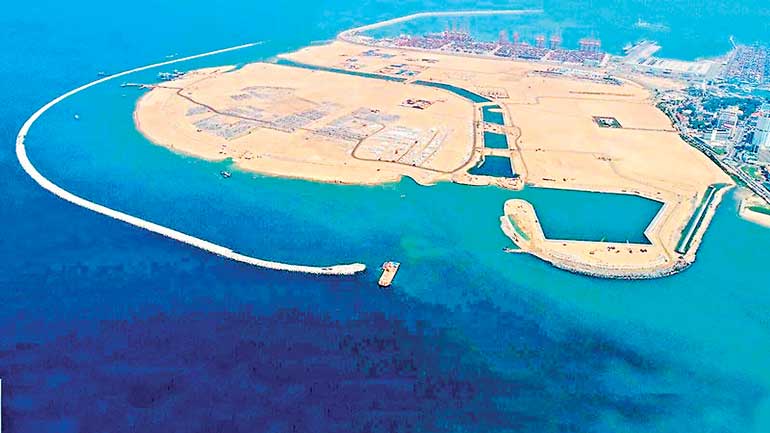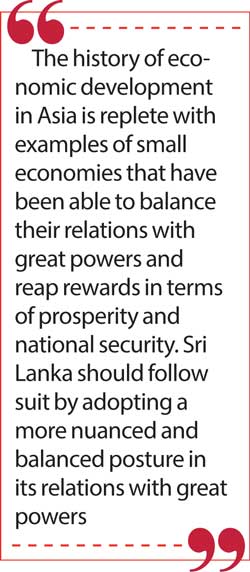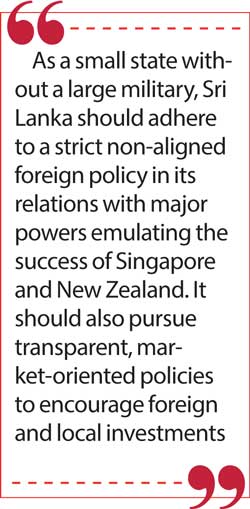Monday Nov 24, 2025
Monday Nov 24, 2025
Tuesday, 25 May 2021 00:00 - - {{hitsCtrl.values.hits}}

The Colombo Port City, built on reclaimed land from the sea, could be a game changer for modern service sector growth. Handled correctly with a supportive regulatory and marketing framework, the ambitious project might gradually position Sri Lanka as the ‘Dubai of South Asia’ in a post-COVID world economy
As it looks towards a post-COVID-19 world, Sri Lanka, with its strategic location in the Indian Ocean, faces the stark policy choice of either tilting towards China or balancing its ties with the great powers. While China’s successful pandemic diplomacy and commercial focus has made it economically important, it is timely for the island nation to reap additional rewards by following a more nuanced and balanced posture in its relations with China, the United States and India
 The visit of Chinese Defence Minister General Wei Fenghe to Sri Lanka in late April 2021 – the second visit by a high-ranking Chinese official since the pandemic – has raised eyebrows in New Delhi and Washington DC. During bilateral talks with President Gotabaya Rajapaksa, the two countries agreed to strengthen defence and economic ties. Sri Lanka requested China’s assistance to mitigate the economic crisis arising from COVID-19, which saw its economic growth collapse to -3.6% in 2020, and for the training of military personnel.
The visit of Chinese Defence Minister General Wei Fenghe to Sri Lanka in late April 2021 – the second visit by a high-ranking Chinese official since the pandemic – has raised eyebrows in New Delhi and Washington DC. During bilateral talks with President Gotabaya Rajapaksa, the two countries agreed to strengthen defence and economic ties. Sri Lanka requested China’s assistance to mitigate the economic crisis arising from COVID-19, which saw its economic growth collapse to -3.6% in 2020, and for the training of military personnel.
During a phone call with President Xi Jinping at the end of March 2021, President Rajapaksa was invited for an official visit to Beijing. Strategically located in the centre of the Indian Ocean, Sri Lanka has become entangled in great power rivalries since the end of a 30-year civil conflict in 2009. Meanwhile, adopting a tough line on China in its first months in office, the Joe Biden administration is looking to contain China’s military and economic power in Asia with the help of its allies – a key difference from the Donald Trump administration.
Although India is being ravaged by a new wave of COVID-19, its foreign and defence establishment is closely watching developments in neighbouring Sri Lanka. As national security and economic development in Sri Lanka is being shaped by geopolitical rivalries, it is useful to examine China’s pandemic diplomacy, Sri Lanka’s recent tilt towards it using the prism of cost-benefit analysis and ways to better balance ties with the great powers.
China’s smart pandemic diplomacy
In 2020-2021, as a sign of closer ties, China stepped up its assistance to Sri Lanka in the areas of healthcare, development finance and trade to help it mitigate the effects of the pandemic. Following the first visit by a high-ranking Chinese official, Communist Party Politburo Member Yang Jiechi, a $ 90 million grant in October 2020 was provided for medical care, education and water supplies. In a headline grabbing move, in March 2021 the People’s Bank of China signed a currency swap agreement with the Central Bank of Sri Lanka for 10 billion Yuan for bilateral trade and investment, and in March 2021, the China Development Bank gave Sri Lanka the second tranche of $ 500 million of a $ 1 billion loan to help ensure fiscal stability.
In a bid to advance its so-called vaccine diplomacy, in March 2021, China also provided 600,000 doses of Sinopharm vaccine to Sri Lanka stipulating that the vaccine should be first used to vaccinate Chinese employees working on development projects. In early May 2021, after the World Health Organization approved the Sinopharm vaccine for emergency use, Sri Lanka began to roll it out to high-risk groups in the Western Province. China has said it would supply more vaccines to the country and maybe invest in a vaccine production facility jointly with the State Pharmaceutical Corporation of Sri Lanka.
Data suggests that the quantum of China’s direct COVID-19 assistance to Sri Lanka is greater than the combined total of that from the United States (US) and India. The US has donated $ 6 million in COVID-10 assistance to Sri Lanka for testing and health services while the US Agency for International Development has programs to support economic recovery there amounting to another $ 71 million. While such direct assistance seems relatively small, the US remains Sri Lanka’s second largest export market due to a strong performance of garment exports and is one of the few countries with whom it enjoys a bilateral trade surplus.
In addition, Sri Lanka’s garment exports could benefit from a US economic recovery engineered by the Biden administration’s $ 1.9 trillion stimulus. Looking at India, the Central Bank Sri Lanka received a $ 400 million currency swap under the South Asian Association of Regional Cooperation framework from the Reserve Bank of India. Furthermore, India’s gift of 500,000 doses of the Astra-Zeneca vaccine kicked off Sri Lanka’s vaccination program.
However, the advent of the new wave of the pandemic and supply bottlenecks at the Serum Institute in Pune have seen India placing restrictions on vaccine exports which has affected the vaccination programs of its neighbours. A previous Indian grant of $ 7.6 million in 2016 for a free ambulance service has improved Sri Lanka’s COVID-19 health response by taking patients to hospitals.
A tilt to China?
China and Sri Lanka have enjoyed warm diplomatic ties since the latter recognised the former in 1950, supported China’s accession to the United Nations and signed a rubber-rice barter deal in 1952. The two established formal diplomatic relations in 1957. As a token of appreciation, China gifted and built an international conference centre – emulating the design of the Great Hall of People in Beijing – for Sri Lanka to host the 1976 Non-Aligned Conference chaired by Prime Minister Sirimavo Bandaranaike.
But China’s global rise since opening up its economy to foreign trade and investment under Deng Xiaoping in 1978 inevitably led to the transformation of its diplomatic relations with Sri Lanka into a more focussed commercial direction.
International interest has focussed on the economic impact of Belt and Road Initiative (BRI) projects on Sri Lanka. But Chinese involvement in the infrastructure sector in there predates the launch of the BRI in 2013. The cumulative value of Chinese infrastructure investment in Sri Lanka was about $ 13 billion between 2006 and August 2020, which as a share of gross domestic product (GDP) is less than the figures for Pakistan and Laos PDR.
Some projects have brought greater benefits to Sri Lanka’s economy than others, such as the Colombo International Container Terminal, which has allowed the deep-water Colombo Port to manage nearly one-third of India’s trans-shipment trade. 
The adjacent Colombo Port City, built on reclaimed land from the sea, could be a game changer for modern service sector growth. Handled correctly with a supportive regulatory and marketing framework, the ambitious project might gradually position Sri Lanka as the ‘Dubai of South Asia’ in a post-COVID world economy.
However, the benefits of some smaller projects such as the Colombo Lotus Tower (a delayed telecommunications and leisure project) and the Magam Ruhunupura International Convention Centre (built for conferences and performing arts in a location 260 kilometres from Colombo) seem less clear.
Moreover, rising imported inputs from China for construction projects in Sri Lanka have widened the significant trade deficit between the two countries ($ 3.8 billion in 2019) while Sri Lanka’s exports to China have remained sluggish. There are also less visible economic spillovers from Chinese projects in terms of foreign investment into the Sri Lankan manufacturing sector, technology transfer and local job creation.
The Chinese debt trap is another contentious issue. Since the early 2000s, China has become an important provider of commercial loans to Sri Lanka for infrastructure projects. There are claims that by accepting such loans, Sri Lanka is becoming stuck in a ‘debt trap’. The Hambantota Port, built in southern Sri Lanka with Chinese commercial loans, which is being managed by a Chinese state-owned enterprise on a 99-year lease, has become a poster child for the Chinese debt trap narrative.
The Hambantota Port deal brought in a world-class port operator to promote its commercial development and the adjacent export processing zone can be leveraged to attract export-oriented foreign investment over time. Sri Lanka is not in a Chinese debt trap but could be at risk in the future if unfettered borrowing on commercial terms were to continue.
According to the latest data from Sri Lanka’s Ministry of Finance, as of August 2020, only around 10% of the Sri Lankan Government’s outstanding debt stock was owed to China compared with 47% owed to financial markets, 22% to multilateral development banks, 10% to Japan and 2% to India. Sri Lanka’s generally high debt to GDP levels over recent decades, which have risen during the pandemic, reflect a persistent fiscal deficit, notable currency depreciation, the costs of a 30-year civil conflict that ended in 2009 and lacklustre post-conflict growth.
Indian security concerns
Senior Indian officials are also concerned that a growing Chinese footprint risks violating Sri Lanka’s sovereignty and threatens India’s southern flank and its national security. The visit of a Chinese Type 039 ‘Song’ class submarine to Colombo in 1994 elicited a strong diplomatic protest from India. Concerns that the Chinese managed Hambantota Port could become a dual use commercial/military facility have heightened following India-China skirmishes in the Himalayas in 2020.
In an attempt to reassure India, Sri Lanka’s Navy manages port calls by foreign ships and security at Hambantota Port. The capacity of the Sri Lanka Navy to undertake maritime patrol activities has been augmented by purchases of two offshore patrol vessels manufactured by Goa’s shipbuilders in India, the gift of a high endurance Hamilton class cutter from the US and a gift of Type 053 frigate from China. India-Sri Lanka defence cooperation has been bolstered by regular dialogues, navy exercises and training in India for the Sri Lankan armed forces. The US assisted the Sri Lanka Navy to establish a Sri Lankan Marine Corps and conducts exercises with the Sri Lankan Navy and Air Force in maritime security and humanitarian assistance and
disaster relief.
A balanced and nuanced approach
The history of economic development in Asia is replete with examples of small economies that have been able to balance their relations with great powers and reap rewards in terms of prosperity and national security. Sri Lanka should follow suit by adopting a more nuanced and balanced posture in its relations with great powers. So, what is the outlook for Sri Lanka’s relations with great powers?
China-Sri Lanka economic ties seem set to expand in the future following the high-level visits of Chinese officials to Sri Lanka and President Rajapaksa’s eventual visit to Beijing. Transitioning towards a new phase in bilateral economic ties – from a foreign borrowing relationship to one emphasising trade and investment – is required for Sri Lanka to reap greater gains from its ties with China.
The future agenda includes attracting Chinese investment into the industrial zone adjacent to Hambantota Port, concluding the Sino-Sri Lanka Comprehensive Partnership on favourable market access terms for Sri Lankan exporters, thereby reducing the trade deficit favouring China, and encouraging technology transfer from China to modernise Sri Lanka’s lagging agricultural sector to ensure food security. Better infrastructure master planning and capacity building would enhance the gains from BRI projects to Sri Lanka.
To reduce the risk of a future Chinese debt trap, Sri Lanka should negotiate debt standstills with its creditors, improve its borrowing and debt management systems, and build its external reserve buffers by prudent macroeconomic management. Starting discussions on an International Monetary Fund program might also reassure financial markets, rating agencies and even Chinese creditor institutions which have expressed concerns about Sri Lanka’s unfavourable debt dynamics after the COVID-19 economic shock.
Sri Lanka has signalled the resetting of ties with the US in anticipation of a more active American role in a post-COVID-19 world. In November 2020, President Rajapaksa congratulated then President-elect Biden and said that he looked forward to working with him. But, against a likely rise in US-China trade, technology and military rivalries, the Biden administration will expect Sri Lanka to match words with deeds. Future talks could explore enhancing US-Sri Lanka cooperation in the maritime domain under the Indo-Pacific strategy and ways of attracting US investment in agro-industries, pharmaceuticals and healthcare and information technology (IT) services.
The same is likely of the Narendra Modi administration once it manages to control the new wave of the pandemic and prioritises the stabilisation of the Indian economy. As a small state without a large military, Sri Lanka should adhere to a strict non-aligned foreign policy in its relations with major powers emulating the success of Singapore and New Zealand. It should also pursue transparent, market-oriented policies to encourage foreign and local investments.
An amended Colombo Port City Economic Commission law was just passed creating a powerful body to oversee activities within the special economic zone (SEZ). A regulatory framework for SEZ should be adopted following good practice principles enshrined in successful mixed commercial and leisure developments internationally. A legal and regulatory framework for the Colombo Port City should be adopted following good practice principles enshrined in successful mixed commercial and leisure developments internationally.
These can be marketed to Indian companies in the services sector such as IT services that may be interested in relocating elsewhere. The Master Plan for the development of the Trincomalee District jointly by India and Singapore should be implemented. Concluding negotiations to upgrade the shallow (goods only) India-Sri Lanka free trade agreement to include provisions on services and investment would encourage deeper economic ties. To further ally India’s security concerns, a trilateral India-Sri Lanka-Maldives maritime safety and security pact may be explored.
These concrete steps could permit Sri Lanka to better exploit its geographical location under the framework of a rules-based multilateral order and to leverage its ties with the great powers for a sustained and peaceful post-pandemic economic recovery.
(Dr. Ganeshan Wignaraja is a Non-Resident Senior Fellow at the National University of Singapore (NUS) and a Senior Research Associate at the Overseas Development Institute (ODI) in London. The views expressed here are solely mine and not be attributed to the NUS or ODI.)